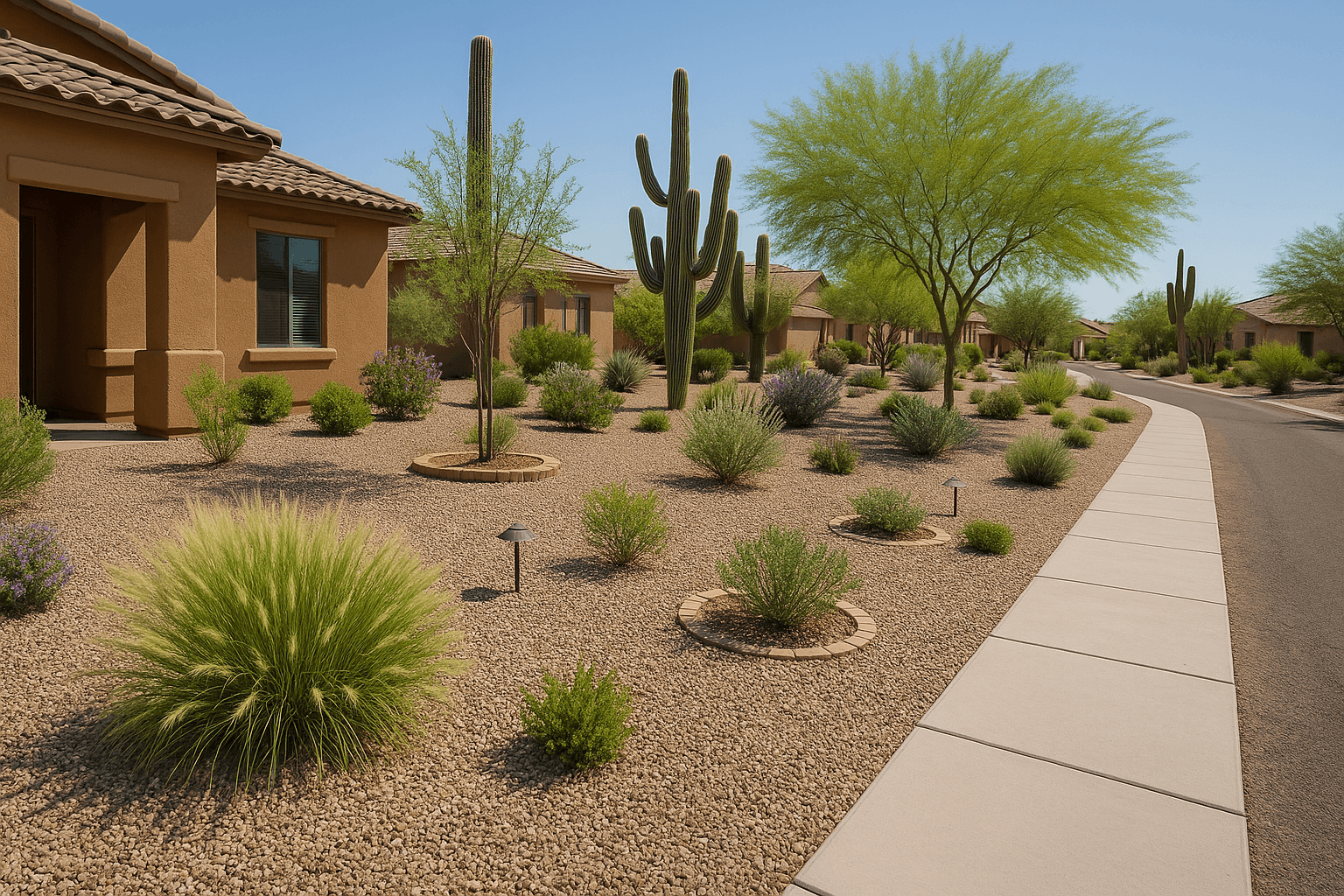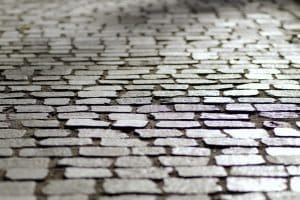Living in Gilbert, we all know that feeling of stepping outside in mid-July and realizing the sun isn’t just shining; it’s actively trying to grill us. Creating a backyard paradise here isn’t just about making it look pretty for a barbecue; it’s about working with our intense desert environment rather than fighting a losing battle against it. Honestly, embracing sustainable landscape architecture is the smartest way to protect your investment and your peace of mind.
Contents
- 1 Wait, What Does “Sustainable” Actually Mean Here?
- 2 The Water Equation: Smart Irrigation and Xeriscaping
- 3 The Hardscape Hero: Permeable Pavers
- 4 Fighting the “Heat Island” Effect
- 5 Lighting: Efficiency Meets Ambiance
- 6 The Soil Ecosystem (It’s Alive!)
- 7 Sourcing Materials Locally
- 8 The Maintenance Reality Check
- 9 Why This Matters for Your Home Value
- 10 Let’s Build Something That Lasts
Wait, What Does “Sustainable” Actually Mean Here?
You hear the word thrown around a lot. Sometimes it feels like a buzzword people use to charge you extra for “organic” dirt. But in the context of Gilbert landscape design, sustainability is really just a fancy word for common sense. It’s about efficiency.
It’s not about turning your yard into a barren wasteland of gravel and a single, sad cactus. Far from it. It’s about creating a lush, functional space that doesn’t require a second mortgage to pay the water bill or every Saturday morning spent mowing.
Here’s the thing: Traditional landscaping—the kind with rolling green lawns and thirsty exotic flowers—was borrowed from places like England or the East Coast. It doesn’t belong in the Sonoran Desert. When we force it, we waste resources. Sustainable landscaping acknowledges that we live in an arid climate and uses techniques that thrive here naturally. It’s balancing what you want (a beautiful yard) with what the land can actually support long-term.
The Water Equation: Smart Irrigation and Xeriscaping
Let’s tackle the elephant in the room—or rather, the elephant in the garden hose. Water. In the East Valley, water conservation isn’t just a suggestion; it’s a necessity. But saving water doesn’t mean you can’t have green.
Xeriscaping is often misunderstood. People hear it and think “zero-scaping.” They imagine endless rocks. But true xeriscaping is an art form. It utilizes native plants and drought-tolerant species that have adapted over thousands of years to survive our brutal summers and low rainfall.
- The Native Advantage: Plants like the Desert Spoon, Red Yucca, or the Velvet Mesquite don’t just survive here; they flourish. They attract local wildlife, require minimal fertilizer, and look stunning against our natural soil tones.
- Smart Irrigation: If you’re still using spray heads that mist water into the air (where half of it evaporates before hitting the ground), you’re throwing money away. We prefer drip irrigation systems. These deliver water directly to the root zone. It’s targeted, precise, and efficient.
You know what? Even the timing matters. Smart controllers now check local weather data to adjust watering schedules automatically. If a monsoon hits Gilbert hard, the system knows to skip the next watering cycle. That’s technology working for your wallet.
The Hardscape Hero: Permeable Pavers
Since we are Gilbert Paver Company, this is where we get a little technical—but stick with me, because this matters. Hardscaping (your patios, walkways, driveways) plays a massive role in sustainability.
In a typical neighborhood, when it rains, the water hits concrete, picks up oil and pollutants, and rushes into the storm drains. It’s a wasted opportunity.
Enter permeable interlocking concrete pavers.
These aren’t just standard bricks with gaps. The entire system underneath is designed to manage water. The joints between the pavers are filled with small stones, allowing water to drain through the surface rather than running off it.
| Feature | Traditional Concrete Slab | Permeable Paver System |
|---|---|---|
| Water Drainage | High runoff; water pools on top | Drains through surface into sub-base |
| Groundwater Recharge | None | Returns water to the soil naturally |
| Heat Absorption | High (Heat Island Effect) | Lower (Airflow in voids cools surface) |
| Durability | Cracks with ground shifting | Flexible; moves with the earth |
When we install these, we put down layers of aggregate (crushed rock) underneath. This acts as a reservoir. During a heavy monsoon, the water is captured there and slowly seeps back into the ground. It reduces strain on the city’s drainage and keeps your property from turning into a swimming pool. Plus, permeable pavers are incredibly durable. Since they “float” on the aggregate, they don’t crack like rigid concrete when the ground swells or settles.
Fighting the “Heat Island” Effect
Have you ever walked across a parking lot in August and felt the heat radiating up through your shoes? That’s the heat island effect. Concrete and asphalt absorb solar energy all day and release it at night, keeping our city hotter than the surrounding desert.
Your backyard can either contribute to this or help fight it.
Sustainable landscape architecture involves choosing materials with a high Solar Reflectance Index (SRI). Lighter-colored pavers, for instance, reflect more sunlight than dark asphalt or grey concrete. This keeps your patio cooler to the touch.
But it’s not just about the stone. It’s about shade.
Strategically planting shade trees is one of the most effective ways to cool a home. A well-placed Palo Verde or Ironwood tree on the south or west side of your house can lower indoor temperatures significantly. It acts as a natural air conditioner for your yard. And honestly, sitting under the natural canopy of a tree feels about ten degrees cooler than sitting under a solid metal patio cover. The tree breathes; the metal just radiates.
Lighting: Efficiency Meets Ambiance
Lighting is often an afterthought, but it’s a huge part of the energy footprint of your landscape. If you’re still using old halogen bulbs to light up your walkway, you might be surprised by how much energy they draw.
We almost exclusively recommend LED landscape lighting.
- Longevity: They last practically forever. You aren’t changing bulbs every few months.
- Energy Draw: They use a fraction of the power. You can light up an entire backyard for the same wattage as a single old-school floodlight.
- Light Pollution: This is a big one for Arizona. We love our dark skies. Sustainable lighting design uses “down-lighting” and shielded fixtures to keep the light focused on the path or the tree, not shooting up into the sky. It preserves that beautiful view of the stars we get out here in Gilbert.
It creates a mood, you know? It’s soft and inviting rather than harsh and glaring.
The Soil Ecosystem (It’s Alive!)
Dirt is just dirt, right? Not exactly. In sustainable landscaping, we focus on soil health.
Our native soil in Gilbert can be… challenging. It’s often heavy clay or caliche (that cement-like layer that breaks shovels). The conventional approach is to dig it out and dump chemical fertilizers on top. But that creates a dependency. The plants get hooked on the chemicals and can’t survive without them.
A better approach involves organic amendments and composting. By adding organic matter, we improve the soil structure. It helps sandy soil hold water and helps clay soil drain better.
Also, we stopped using those black plastic weed barriers under gravel years ago. Why? Because they kill the soil. They prevent air and water from reaching the earth, effectively killing the microorganisms that keep soil healthy. Eventually, dirt settles on top of the plastic, and weeds grow anyway. It’s a mess.
Instead, we use a thick layer of organic mulch or properly installed inorganic mulch (rock) with appropriate depth to suppress weeds naturally while letting the ground breathe.
Sourcing Materials Locally
This is a logistic thing, but it matters. If you buy a specific type of stone that has to be trucked in from Pennsylvania or shipped from Italy, the carbon footprint of that patio is massive. The fuel used just to get the rock to your Driveway negates a lot of the “green” benefits.
We are lucky in Arizona. We have incredible local sources for materials.
- River Rock: Sourced from local riverbeds.
- Flagstone: We have amazing quarries in Northern Arizona.
- Pavers: Many high-quality pavers are manufactured right here in the Phoenix metro area.
Using locally sourced materials doesn’t just save fuel; it usually looks better. The colors of local stone match the colors of the local mountains and dust. It feels cohesive. It ties your home into the landscape of the San Tan Valley rather than looking like it was dropped from outer space.
The Maintenance Reality Check
Here is the part where I contradict myself a little bit—but let me explain. Sustainable landscaping is low maintenance, but it isn’t no maintenance.
A sustainable yard changes with the seasons. Native plants grow, bloom, and go dormant. They drop pods. They need pruning. However, compared to a traditional lawn that needs mowing, edging, aerating, and fertilizing constantly, a sustainable landscape is a breeze.
You spend less time working on your yard and more time enjoying it.
Think about the noise, too. No gas blowers, no lawnmowers running at 7:00 AM on a Saturday. Just the sound of the wind in the trees and maybe a fountain running (recirculating water, of course).
Why This Matters for Your Home Value
Let’s talk numbers for a second. You might be thinking, “This all sounds great, but does it pay off?”
Absolutely.
Homebuyers in Gilbert are savvy. They know what high water bills look like. When they see a home with a lush, drought-tolerant landscape, high-quality paver hardscaping, and energy-efficient lighting, they see value. They see a home that is cheap to run and easy to own.
A well-designed, sustainable landscape extends your living square footage. It turns your yard into an outdoor room that is usable year-round. Whether it’s a Fire Pit area for those chilly winter nights or a shaded paver patio for spring brunch, these features yield a high return on investment.
Let’s Build Something That Lasts
At the end of the day, sustainable landscape architecture is about legacy. It’s about building something that will look as good in twenty years as it does today. It’s about respecting the desert we call home while creating a sanctuary for your family.
Whether you are looking to rip out that old, thirsty lawn or you want to install a cutting-edge permeable paver driveway, Gilbert Paver Company has the expertise to make it happen. We don’t just lay bricks; we design solutions.
Ready to transform your outdoor space into a sustainable oasis?
Give us a call at 480-534-9680
Or [Request a Free Quote] right now.
Let’s make your neighbors jealous and your water bill happier.




